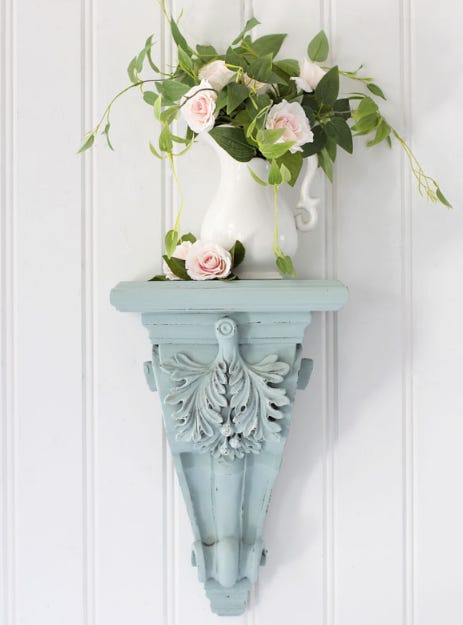Decorating with Corbels and Brackets
My tribute to the ornamental corbel lit Pinterest on fire. Now I'm bringing it to Substack.
I’ve admired decorative corbels ever since my days as editor of Victorian Homes magazine. A few years ago, I jumped on the corbel car and wrote a tribute on my former website, She Shed Living. I posted a few pins on Pinterest and watched, mouth agape, as engagement climbed through the stratosphere.
You too will be amazed at how much impact these architectural pieces add to a space once you really look at them. Whether plain, country, modern, Italianate, or Baroque, the corbel is an element of historic continuity. It has been used on buildings in places of prominence since Neolithic times. The sturdy corbel provides support while exuding strength and character.
What Exactly Is a Corbel?
A versatile and beautiful architectural element, the corbel is a triangular shaped piece made of plaster, wood or stone. It’s been used as building support for many centuries.
Typically corbels were embedded into a wall so that the flat top of each one could help bear the weight of a ceiling or roof. Despite their utilitarian purpose, corbels were often elaborately carved and decorated.
Decorative corbels are often used to define a passthrough, such as a hallway, or to frame the transition between two rooms. Wood corbels are usually routed and carved, featuring sensuous curves and depictions of fruit, acanthus leaves and flourishes.
Corbel Embellishment
I know what some of you are thinking: corbels belong to the past. Used with abandon in neo-traditional kitchens built between 1995 and 2015, gigantic corbels were attached to the corners of every kitchen island and stove vent hood. It was too much and now this venerable architectural element faces a PR problem.
Photo courtesy On a Budget | Produced by Kerry Taylor Scates
Used with care and restraint, however, the corbel is a beautiful thing. Think of it as a sculptural piece that inspires quiet admiration — pay attention to quality and scale. Antique corbels are routinely removed (and — ack! — tossed) when older buildings are torn down. Some are salvaged, thankfully, and you will find them at flea markets, antiques malls and places like Habitat for Humanity’s ReStore locations. New ones can be purchased online or even made by hand.
Below are some room-refreshing ways to use corbels, adding substance and visual interest wherever your imagination takes you:
Photo courtesy Tracey Hiebert | Hydrangea Farmhouse
Nothing dresses up a she shed or a blank interior wall more than a bracketed “awning” — even if it’s purely decorative. Here Tracey Hiebert used decorative metal brackets to support a plain wood shelf. Placed above the door and window line, the whole thing creates an awning effect and adds interest to the front entrance.
Christy James is a pro at turning thrift store finds into gorgeous home décor. This pretty painted corbel shelf is part of a DIY article on her blog that has lots of great ideas. (Photo courtesy Christy James | Confessions of a Serial DIYer
One of the most popular ways to use corbels is underneath display shelves, or as a micro shelf on its own. Keep the original patina on antique corbels or use new ones and paint everything in the color of your choice.
If you don’t want the formality of a traditional window treatment but want to dress up your windows in some other way, consider a pretty flanking of corbels on each side. In this case, the window “valance” is created with a vintage louvered shutter. Kim Brandstater of Lavender Marketplace Workshops dressed up her ceramics studio with lots of corbels and vintage architectural elements. You can also use a pretty wood plank or a metal rod if you want to hang some simple curtain panels.
Photo by Mark Loman | Styled by Sunday Hendrickson
Corbels are welcome visual additions to almost any room in the house or apartment. Use them in the living room for bookshelves or display shelves, as side or coffee table legs or worked into a bedroom headboard. Here, a rustic bathroom vanity is elevated by matching architectural corbels. Their size is in perfect proportion to the vanity top.
Photo courtesy Kim DeCamp Robinson | Shiplap and Shells
Here is a great way to enhance a transition between two rooms. It also works really well on a she shed porch as an elegant framework. Kim DeCamp Robinson of the popular garden and home décor site Shiplap and Shells came up with this idea for the transition between her living room and kitchen. “There was a wall between the two rooms when we moved in nine years ago,” she explains. Kim went even further, installing a turned post that fit onto the top of the kitchen’s banquette bench on the right, and down to the floor on the left.
Photo courtesy Kim DeCamp Robinson | Shiplap and Shells
This corbel project is not a slam-dunk in a day; it requires some construction elbow grease. The design and installation took Kim and her husband a few weeks to complete and the paint-and-stain finish took a few weeks longer. But it can be done as a DIY if you have the inspiration and patience! The results are pretty stunning.
My own little she shed back in Huntington Beach was enhanced by a pair of gorgeous brass brackets given to me by my friend Hillary. The little curved ends can hold aprons, Christmas holly and other sundry objects as a nod to their ancient corbel ancestors’ functional value.











So cute!